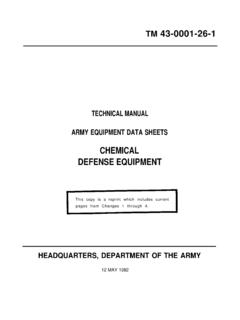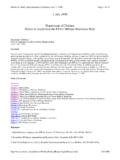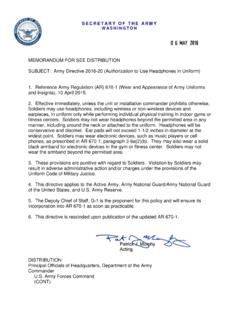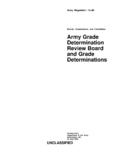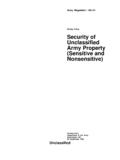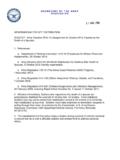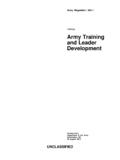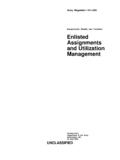Transcription of Army Pamphlet 385-64 Ammunition and …
1 Department of the army Pamphlet 385 64. safety Ammunition and explosives safety standards Headquarters Department of the army Washington, DC. 15 December 1999. UNCLASSIFIED. SUMMARY of CHANGE. DA PAM 385 64. Ammunition and explosives safety standards This change 1-- o Incorporates recent changes to explosives safety criteria of DOD , DOD Ammunition and explosives safety standards . o Incorporates requirements previously only contained in TM 206-1300-9. (rescinded) (para 2-6). o Adds requirements for underground facilities (para3-23, para 5-13, figure 5- 10, and para 6-3c). o Adds requirements for plans to provide safety , security, and environmental protection in emergency response (para 3-24). o Adopts DOD revisions to criteria for hazard division (app I). o Provides corrections to quantity-distance requirements for public highways (para 5-6). o Provides corrections to unbarricaded intraline distance requirements (para 5-6d(3)). o Provides corrections to facilities siting criteria (chap 5).
2 O Provides corrections to magazine siting criteria (chap 5). o Corrects/updates quantity-distance tables (chap 5). o Adds requirements for surge suppression for incoming conductors to include suppression at the entrance to the building from each wire to ground (para 6- 5b). o Corrects qualification requirements for personnel responsible for electrical maintenance, inspection and testing (para 6-13c(1)). o Clarifies lighting protection electrical test requirements for earth covered magazines (table 6-1). o Corrects DD Form 626 inspection requirements motor vehicles loaded with explosives , Ammunition , or other hazardous material (para 7-7a and 7-8). o Adds information on DOD explosives safety surveys (para 8-1f). o Changes construction requirements for explosives buildings (para 8-5). o Provides changes to requirements for barricaded open storage modules and barricades and earth cover for magazines (para 8-29c, 8-29d(3), and 8-30). o Provides quantity-distance requirements for maritime prepositioning ships (para 11-6d(7)) and table 11-13).
3 O Provides changes to lightning protection requirements (chap 12). o Adds requirements from the Munitions Rule (para 13-29 and chap 19). o Changes safety requirements for contingency deployment Ammunition operations in a less than wartime environment (chap 14). o Changes safety requirements for wartime operations (chap 15). o Changes earth covered magazine criteria (app G). o Adds explosives safety program management requirements (app J). o This new Department of the army Pamphlet -- o Implements and amplifies the explosives safety criteria depicted in DOD. , DOD Ammunition and explosives safety standards (chap 1). o Defines general safety standards for army operations involving Ammunition and/or explosives (chap 2). o Establishes management controls for fire prevention, suppression and protection as applicable to army Ammunition and explosives (chap 3). o Provides an overview of the Joint Hazard Classification System (JHCS) and establishes storage principles for the various compatibility groupings of Ammunition and explosives (chap 4).
4 O Establishes quantities of explosives material and distance separation requirements that provide defined levels of protection (chap 5). o Establishes requirements for the installation and use of electrical service and equipment in army explosives facilities (chap 6). o Defines regulations and guidance regarding shipment of army explosives and other dangerous articles (chap 7). o Establishes requirements and provides definitive material on the preparation and submittal of explosives and toxic chemical site plans (chap 8). o Explains the purpose, denotes minimum requirements and defines responsibilities of the army explosives licensing program (chap 9). o Provides guidance on the appropriate usage of material handling equipment (MHE) for Ammunition and/or explosives operations (chap 10). o Establishes requirements for the movement of army units to ports during times of war, peace, or national emergency (chap 11). o Provides the minimum technical criteria for lightning protection of explosives areas and facilities (chap 12).
5 O Sets forth requirements for storage of Ammunition and explosives within the army (chap 13). o Establishes peacetime operational requirements concerning CONUS and OCONUS. Ammunition and explosives activities, training operations, contingency force operations and airfields used by military aircraft in the theater of operations (chap 14). o Provides guidance for the safe handling, transportation, and storage of Ammunition during wartime and contingency operations (chap 15). o Defines the army criteria pertaining to the storage and handling of commercial explosives (chap 16). o Provides guidance on the requirements and procedures for the disposal of Ammunition , explosives and propellants (chap 17). o Establishes requirements and criteria relative to operations involving maintenance and/or the restoration of Ammunition and explosives to a serviceable condition (chap 18). Headquarters Department of the army Department of the army Pamphlet 385 64. Washington, DC.
6 15 December 1999. safety Ammunition and explosives safety standards of the army . Changes are shown with (USATCES). A copy of all agreements underscore and tint. will also be made a permanent part of the Summary. This Pamphlet provides force real property records. Provisions of this protection guidance for commanders with Pamphlet apply in wartime, peacetime, an Ammunition or explosives mission. It and in contingency situations. provides procedures to protect military Proponent and exception authority. and civilian army employees, the public, The proponent of this Pamphlet is the and the environment. It also sets forth Under Secretary of the army . The Under procedures for use when transporting am- Secretary of the army has the authority to munition or explosives over the public approve exceptions to this Pamphlet that highway. are consistent with controlling law and Applicability. The provisions of this regulation. The Under Secretary of the Pamphlet apply to all army installations army may delegate this authority, in writ- and activities, the army National Guard ing, to a division chief within the propo- (ARNG), the army Reserve nent agency who holds the grade of (USAR), Government-owned, contractor- colonel or the civilian equivalent.
7 History. This publication was originally operated (GOCO) facilities, and contrac- tor operations on Government property. Suggested Improvements. Users are printed on 28 November 1997. It was Ammunition and explosives under ti- invited to send comments and suggested authenticated by Dennis J. Reimer, tle, even though stored in a host country, improvements on DA Form 2028 (Recom- General, United States army , Chief of remain the responsibility of the com- mended Changes to Publications and Staff and Joel B. Hudson, Administrative mander. Storage must conform with army Blank Forms) directly to Director, Assistant to the Secretary of the army . standards for explosives safety unless the army Technical Center for explosives This electronic edition publishes the basic use of other criteria (such as North Atlan- safety . 1997 edition and incorporates change 1. Change 1 was printed on 15 December tic Treaty Organization (NATO) or host Distribution. Distribution of this publi- 1999 and was authenticated by Eric K.)
8 Nation has been agreed to or is mandatory. cation is made in accorance with initial Shinseki, General, United States army , A copy of all agreement documents will distribution number (IDN) 095466, for be provided major army commands command levels D and E for the Active Chief of Staff and Joel B. Hudson, (MACOMs) involved and two will be sent Administrative Assistant to the Secretary army , the army National Guard, and the to the Director, army Technical army Reserve. Center for explosives safety Contents (Listed by paragraph and page number). Chapter 1. Introduction, page 1. Purpose 1 1, page 1. References 1 2, page 1. Explanation of abbreviations and terms 1 3, page 1. Implementation 1 4, page 1. Policy on existing explosives facilities 1 5, page 1. Chapter 2. General safety Precautions, page 1. Hazard analysis and risk assessment 2 1, page 1. Personnel qualifications 2 2, page 2. Use of written standards 2 3, page 2. DA PAM 385 64 15 December 1999 i UNCLASSIFIED.
9 Contents Continued Personnel and explosives limits 2 4, page 2. Handling and movement precautions 2 5, page 2. Housekeeping 2 6, page 3. Testing, disassembly, and modification of explosives items 2 7, page 4. Explosive ordnance disposal training aids 2 8, page 4. Field safety 2 9, page 5. Accident reporting 2 10, page 5. Rod and gun clubs 2 11, page 5. Public demonstrations, exhibitions, and celebrations 2 12, page 5. Static or public display 2 13, page 6. explosives training aids for military working dogs 2 14, page 6. Hunting 2 15, page 6. Chapter 3. Fire Prevention, Protection, and Suppression, page 9. Fire prevention management 3 1, page 9. Smoking 3 2, page 9. Training 3 3, page 10. Fire drills 3 4, page 10. Fire exit drills 3 5, page 10. Alarms 3 6, page 10. Fire prevention requirements 3 7, page 10. Auxiliary firefighting equipment 3 8, page 12. Storage of water for firefighting 3 9, page 13. Access to fire hose 3 10, page 13. Limitation of fire areas 3 11, page 13.
10 Reciprocal agreements for fire fighting support 3 12, page 13. Public withdrawal distances 3 13, page 13. Firefighting guidance symbols 3 14, page 14. Posting fire symbols 3 15, page 14. Exceptions on posting fire symbols 3 16, page 14. Posting chemical hazard symbols 3 17, page 15. Procedures for chemical agents and other toxic substances 3 18, page 15. Firefighting at railheads 3 19, page 15. Automatic sprinkler systems 3 20, page 15. Deluge systems for explosives operations 3 21, page 15. Instructions for fighting fires involving Ammunition or explosives 3 22, page 17. Reentry of underground facilities 3 23, page 18. Emergency planning 3 24, page 18. Chapter 4. Hazard Classification and Compatibility Groups, page 29. explosives hazard classification procedures 4 1, page 29. EIDS and EIDS Ammunition 4 2, page 29. Storage principles 4 3, page 30. Mixed storage 4 4, page 30. Storage compatibility groups 4 5, page 30. Class 1 or 6 chemical agent hazards or combined chemical agent and explosives hazards 4 6, page 31.




